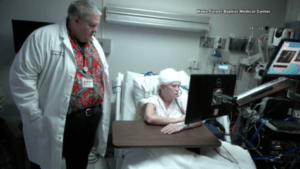
Promising at least and it is actually a way to stimulate the memory function. Not targeted so much as inducing the known driver to perform better. In the process clear cut memory functions appear restored.
What we forget though is that the majority of memory input is dismissed because it does not have importance and this can only expand with age.
all good..
.
Prosthetic Memory System Successfully Implemented In Humans
4Apr
by Ben Renner -
Brain StudiesHealth StudiesIntelligence StudiesTechnology Studies
https://www.studyfinds.org/prosthetic-memory-brain-memories/
WINSTON-SALEM, N.C. — We’re familiar with the amazing power of prosthetic limbs, but scientists have taken the power of prostheses to a new level. A pilot study conducted by a team of researchers from Wake Forest Baptist Medical Center and the University of Southern California successfully implemented a prosthetic memory system in a human brain.
The technology taps into an individual’s natural memory patterns to strengthen the brain’s ability to encode and recall information. Researchers found that the system improved a patient’s short-term memory performance by nearly 40 percent. In particular, it helps with an individual’s episodic memory, which is what Alzheimer’s patients or those who suffer strokes and head trauma typically see weaken.

Scientists at Wake Forest Baptist Medical Center and the University of Southern California have demonstrated the successful implementation of a prosthetic memory system in humans. (Video image courtesy Wake Forest Baptist Medical Center)
The study tested the prosthetic memory system on epilepsy patients who were already participating in a diagnostic brain-mapping procedure using surgically-implanted electrodes in different parts of the brain to detect seizures. They sought to influence the firing patterns of neurons in hippocampus, the part of the brain that oversees new memories.
To do this, the scientists used the electrodes to record the firing patterns while the patients participated in a computerized memory test. The patients were shown an image, and then after a brief pause in which the screen went black, they were tasked with picking that image out of a group of others. When correct responses were made, the team was able to create a unique “code” from the neural firing patterns.
The researchers then synthesized that code within the prosthetic memory system and played it back to the patients as they performed the image task again. Participants showed a 37 percent improvement in correct responses using the system.
“This is the first time scientists have been able to identify a patient’s own brain cell code or pattern for memory and, in essence, ‘write in’ that code to make existing memory work better, an important first step in potentially restoring memory loss,” explains study lead author Dr. Robert Hampson, a professor of physiology/pharmacology and neurology at Wake Forest Baptist, in a news release.
A second test had participants perform the same memory task, but had to wait up to 75 minutes before being asked to pick the correct original image. When the prosthetic memory system was activated with the longer delay, participants showed a 35 percent improvement in recall.
“We showed that we could tap into a patient’s own memory content, reinforce it and feed it back to the patient,” says Hampson. “Even when a person’s memory is impaired, it is possible to identify the neural firing patterns that indicate correct memory formation and separate them from the patterns that are incorrect. We can then feed in the correct patterns to assist the patient’s brain in accurately forming new memories, not as a replacement for innate memory function, but as a boost to it.”
The researchers hope the technology as they continue to build it will eventually help people recall long-term memories that are particularly meaningful to patients.
“To date we’ve been trying to determine whether we can improve the memory skill people still have. In the future, we hope to be able to help people hold onto specific memories, such as where they live or what their grandkids look like, when their overall memory begins to fail,” says Hampson.
The study, funded by the United States Defense Advanced Research Projects Agency, was published March 28th in the Journal of Neural Engineering.
No comments:
Post a Comment